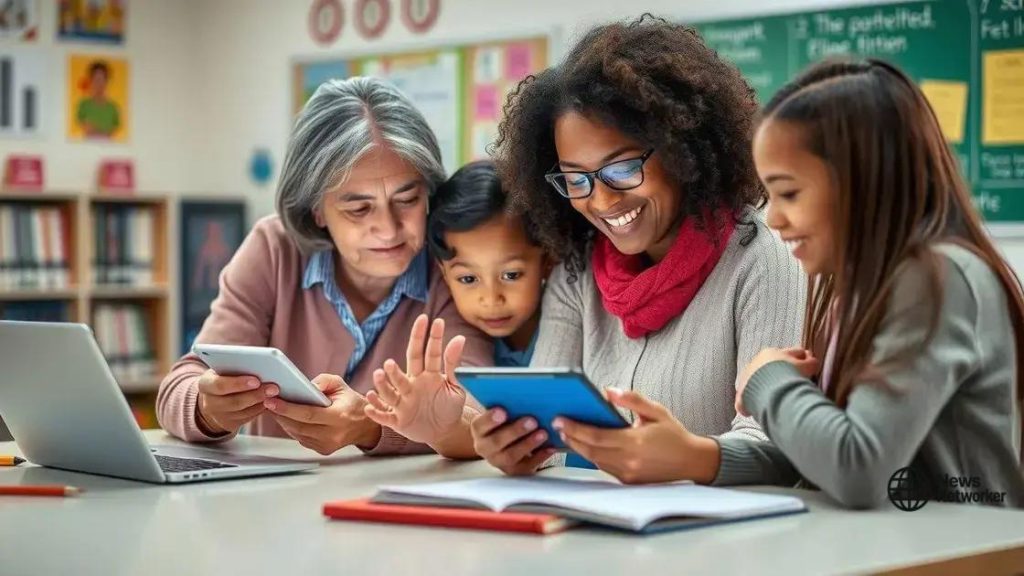Digital tools for parent-school communication: enhance engagement

Digital tools for parent-school communication enhance engagement and collaboration by providing real-time updates, promoting personalized interactions, and ensuring a secure flow of information between parents and educators.
Digital tools for parent-school communication are changing how families interact with educational institutions. Have you ever thought about how much easier it could be to stay informed and involved? In this article, we’ll explore different tools that enhance parent-teacher collaboration.
Understanding the importance of communication tools
Understanding the importance of communication tools is essential for effective parent-school interactions. These tools help bridge the gap between home and the classroom, making it easier for parents to stay informed about their child’s education.
Schools today are leveraging various digital platforms to enhance communication. This shift has made it possible for parents to receive real-time updates and engage with teachers more efficiently.
Benefits of Effective Communication Tools
Using communication tools offers several key benefits:
- Improved information sharing between parents and educators.
- Increased engagement in a student’s educational journey.
- Timely updates on events, grades, and school news.
- Enhanced collaboration for student success.
Furthermore, these tools support the dynamic nature of our society. With busy schedules, it can be challenging for parents to connect directly with teachers. This is where technology plays a crucial role. By utilizing apps, emails, and portals, parents can manage communication at their convenience.
Additionally, fostering a strong partnership between the school and home environment positively impacts a child’s learning experience. When parents feel informed and involved, they are more likely to contribute to their child’s education in meaningful ways. The seamless flow of information nurtures trust and creates a supportive atmosphere.
Ultimately, recognizing how vital communication tools are for parent-school relationships can lead to better educational outcomes for students. Schools that embrace these technologies are setting the stage for enhanced collaboration, paving the way for a brighter future.
Popular digital tools for schools
In today’s educational landscape, popular digital tools for schools are transforming how teachers and parents communicate. These tools streamline communication, improve engagement, and make information more accessible.
Some well-known tools include:
Communication Platforms
- ClassDojo: This app allows teachers to share updates on students’ progress with parents. It encourages positive behavior and keeps parents in the loop.
- Remind: A messaging app that connects teachers with students and parents. It’s great for sending reminders about assignments and events.
- Seesaw: Teachers can create a digital portfolio for each student. Parents can view their child’s work and see real-time updates.
These tools offer various features that facilitate communication. For instance, many platforms allow for instant messaging and image sharing, creating a more interactive experience. When schools implement these tools, they foster a stronger school community.
Furthermore, digital tools simplify administrative tasks. For example, schools can use software to manage attendance and grades efficiently. This allows teachers to focus more on teaching rather than paperwork.
In addition, such tools often include features that promote collaboration. Teachers can create groups for parents to discuss issues and share resources, further enhancing the connection between home and school.Popular digital tools for schools not only improve communication but also make education more engaging for students, providing them with a platform to express their learning creatively.
Benefits of using digital communication

Using digital communication tools offers numerous advantages for schools, parents, and students alike. These benefits help create a more connected and engaged educational environment.
One major benefit is the ability to share information quickly. Digital tools allow for instant communication, ensuring that parents receive timely updates about their child’s progress and school events.
Enhanced Engagement
When parents can easily communicate with teachers, they are more likely to become involved in their child’s education. Engaged parents often contribute more to school activities and support their children’s learning at home.
- Real-time feedback on student performance.
- Opportunities for parents to ask questions and seek clarifications.
- Access to resources that aid learning.
Another advantage is the flexibility these tools provide. Parents can check school updates or communicate with teachers at their convenience, making it easier to fit education-related tasks into their busy schedules.
Furthermore, digital communication can foster stronger relationships between parents and teachers. These tools enable meaningful conversations that can lead to partnerships in supporting student success.
Moreover, implementing technology in communication can help reduce misunderstandings. With clear messages and immediate responses, everyone stays on the same page, which is crucial for a productive learning environment.
Overall, the benefits of using digital communication tools in schools are clear. They enhance engagement, provide flexibility, and encourage collaboration between parents, teachers, and students. When effectively utilized, these tools significantly improve the educational experience.
Best practices for effective engagement
Establishing best practices for effective engagement is crucial in fostering strong relationships between parents and schools. These practices ensure that information flows smoothly and collaboration thrives.
One effective strategy is to maintain regular communication. Schools should send out frequent updates to keep parents informed about important events, deadlines, and student progress.
Utilizing Multiple Channels
Employing various communication channels can enhance engagement:
- Email newsletters that summarize important information.
- Social media updates to reach parents where they are most active.
- Dedicated apps for instant notifications about grades and school activities.
Additionally, providing opportunities for parents to participate in school activities boosts engagement. This could include inviting them to workshops, meetings, or volunteer opportunities. When parents feel valued and included, they are more likely to stay engaged.
Feedback is another essential element in the engagement process. Schools should encourage parents to share their thoughts through surveys or suggestion boxes. This shows parents that their opinions are valued and can lead to improvements in the learning environment.
Furthermore, creating a welcoming atmosphere encourages interaction. Schools should ensure that parents feel comfortable reaching out, whether through friendly staff communication or an open-door policy. A supportive environment fosters trust and keeps parents involved in their child’s education.
Lastly, celebrating student achievements with parents can strengthen the relationship between home and school. Recognizing progress not only motivates students but also reinforces the importance of the partnership.
Future trends in parent-school communication
Future trends in parent-school communication are rapidly evolving with advancements in technology and changing educational practices. As schools adapt to these changes, they will offer more dynamic and interactive communication options.
One primary trend is the increasing use of artificial intelligence. AI can help analyze communication patterns and suggest personalized interactions. This can lead to tailored updates that address specific concerns of parents, making them feel more connected to their child’s education.
Integration of Communication Platforms
We can expect to see greater integration of communication platforms. Schools will likely benefit from using unified systems that combine messaging, event calendars, and academic progress reports into one app or website. This convenience can simplify interactions and encourage more frequent communication.
- Centralized information hubs for parent resources.
- Instant messaging for urgent updates.
- Enhanced privacy features to protect sensitive information.
Moreover, video conferencing will continue to play a vital role in parent-teacher meetings. Virtual meetings provide flexibility for parents, allowing them to engage without the need to travel to the school. This could especially benefit families with busy schedules or transportation challenges.
An additional aspect is the increased focus on data security and privacy. As communication moves online, schools will need to ensure that parents’ and students’ data is protected. Implementing strong security measures will be essential for maintaining trust within the school community.
This focus on secure, efficient communication technologies will create stronger partnerships. When families feel secure and informed, they are more likely to engage in their child’s educational journey.
FAQ – Frequently Asked Questions about Digital Tools for Parent-School Communication
What are digital communication tools?
Digital communication tools are platforms that facilitate messaging and information sharing between parents and schools, such as apps and websites.
How can digital tools improve parent engagement?
By providing real-time updates and easy access to information, digital tools encourage parents to participate more actively in their children’s education.
What are some popular digital communication tools used by schools?
Popular tools include ClassDojo, Remind, and Seesaw, which help connect parents with teachers and track student progress.
How can schools ensure data privacy in digital communication?
Schools should implement strong security measures and educate staff and parents about data protection to maintain trust and confidentiality.





